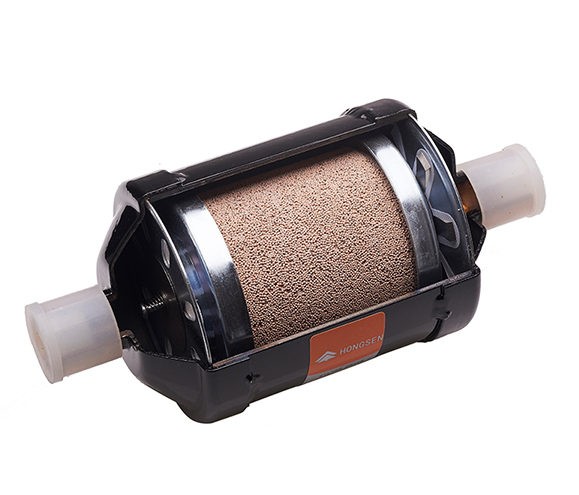
What is inside a filter drier?
1,Where do we find a filter drier?
This is a very typical model filter drier, and we will find these installed in the liquid line of the refrigeration system between the condenser and the expansion valve.
On the side of the filter drier, you will find an arrow. This indicates the direction of refrigerant flow. Some models for heat pumps might be bidirectional, and the arrow will point both left and right. But in this case, we have a single direction, one way filter drier. On the outside, we have a powder painted surface which just prevents corrosion, and the black gloss finish just gives a premium look and feel. The casing is made from steel to give it a strong structure as this will be under some high internal pressure once connected into the refrigeration system. At each end we have some solder connections, which can either be pure copper or copper-plated depending on the model.
2, What do we use a filter drier for?
Their job is to filter and dry the refrigerant. They protect the refrigeration system and its components by capturing and adsorbing water particles, as well as harmful, solid substances. This will prevent them from cycling around the system, and getting into the compressors, the valves, the sensors, etc., to keep the system running in optimal conditions.
3, Let’s look inside at the components.
Now of the refrigerant in that end, we have a large spring. the spring just pushes against both the casing and the solid core. This is just there to keep the core in a fixed position inside the casing.
Next, we have the core, or the molecular sieve. This particular model has a solid core, 80% of which is molecular sieve, and 20% is an activated alumina. I’ll show you some close-ups here of that porous material. The solid core molecular structure acts as a filter to capture any large dirt particles. The material is similar to a sponge, in that it can soak up and retain water. The aluminium or aluminum oxide is added in there to capture and retain the acids. Not all filter driers will have activated alumina inside them, it depends on the application. So the refrigerant enters and surrounds the outside of the core. The pressure of the system forces the refrigerant to pass through the porous material.
Notice this groove inside. The refrigerant will pass through the solid core, and then collect in this groove to continue its flow towards the expansion valve.
At the end of the solid core, we have a screen. This polyester mat retains the smaller dirt particles which might have been able to pass through the solid core. The material is able to capture dirt particles down to 25 microns with minimal pressure drop. After the screen we have a perforated plate. This is just there to keep all the internal parts in position. The holes just allow the refrigerant to flow to the outlet. The refrigerant then leaves the filter drier, and heads to the expansion valve. So the refrigerant enters through the inlet, it passes across the spring, and then surrounds the outside of the solid core. The spring is pushing and holding everything in place. The refrigerant then passes through the solid core, and as it does so, the dirt, moisture, and acids are adsorbed. The refrigerant then collects in the groove of the center of the core, and then it passes through the screen. It then passes through the perforated plate, and exits the unit, having been filtered and dried. The refrigerant then continues to the expansion valve.
Related products
01
REPLACEABLE FILTER DRIER CORE
Libra Replaceable Filter Drier Core is used in refrigeration system to remove system contaminants, acid and moisture

